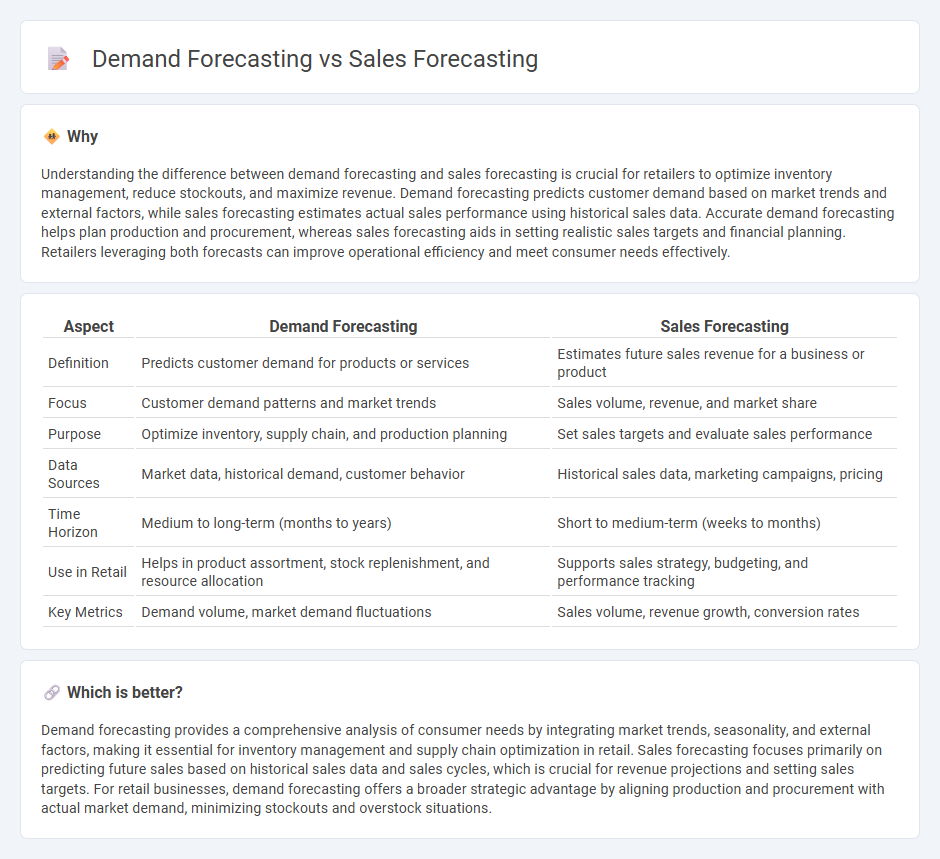
Demand forecasting analyzes future customer demand using market trends and historical consumption data to optimize inventory and production. Sales forecasting predicts upcoming sales revenue by evaluating marketing strategies, sales pipeline, and economic conditions to guide financial planning. Explore the differences and applications of demand forecasting versus sales forecasting to enhance retail performance.
Why it is important
Understanding the difference between demand forecasting and sales forecasting is crucial for retailers to optimize inventory management, reduce stockouts, and maximize revenue. Demand forecasting predicts customer demand based on market trends and external factors, while sales forecasting estimates actual sales performance using historical sales data. Accurate demand forecasting helps plan production and procurement, whereas sales forecasting aids in setting realistic sales targets and financial planning. Retailers leveraging both forecasts can improve operational efficiency and meet consumer needs effectively.
Comparison Table
| Aspect | Demand Forecasting | Sales Forecasting |
|---|---|---|
| Definition | Predicts customer demand for products or services | Estimates future sales revenue for a business or product |
| Focus | Customer demand patterns and market trends | Sales volume, revenue, and market share |
| Purpose | Optimize inventory, supply chain, and production planning | Set sales targets and evaluate sales performance |
| Data Sources | Market data, historical demand, customer behavior | Historical sales data, marketing campaigns, pricing |
| Time Horizon | Medium to long-term (months to years) | Short to medium-term (weeks to months) |
| Use in Retail | Helps in product assortment, stock replenishment, and resource allocation | Supports sales strategy, budgeting, and performance tracking |
| Key Metrics | Demand volume, market demand fluctuations | Sales volume, revenue growth, conversion rates |
Which is better?
Demand forecasting provides a comprehensive analysis of consumer needs by integrating market trends, seasonality, and external factors, making it essential for inventory management and supply chain optimization in retail. Sales forecasting focuses primarily on predicting future sales based on historical sales data and sales cycles, which is crucial for revenue projections and setting sales targets. For retail businesses, demand forecasting offers a broader strategic advantage by aligning production and procurement with actual market demand, minimizing stockouts and overstock situations.
Connection
Demand forecasting and sales forecasting are interconnected processes that enable retailers to predict consumer purchasing behavior and optimize inventory levels. Accurate demand forecasting analyzes market trends, seasonality, and customer preferences to estimate future product needs, while sales forecasting translates these predictions into expected revenue figures. By integrating both, retailers can enhance supply chain efficiency, reduce stockouts or overstock situations, and improve overall business performance.
Key Terms
Historical Sales Data
Sales forecasting relies heavily on historical sales data to predict future revenue by analyzing past trends, seasonality, and sales cycles across various products and regions. Demand forecasting, while also utilizing historical sales figures, integrates broader factors such as market conditions, consumer behavior, and external economic indicators to estimate future product demand more comprehensively. Explore deeper insights into the differences and applications of sales and demand forecasting for optimizing business strategies.
Market Trends
Sales forecasting analyzes historical sales data and customer purchasing behavior to predict future sales volumes, helping businesses set realistic revenue targets. Demand forecasting emphasizes market trends, consumer preferences, and external factors like economic conditions to estimate product demand accurately and optimize inventory management. Explore our detailed insights to understand how aligning both approaches enhances strategic planning and market responsiveness.
Inventory Planning
Sales forecasting predicts future revenue based on historical sales data and market trends, while demand forecasting estimates the total customer demand for products, crucial for accurate inventory planning. Precise demand forecasting helps businesses optimize stock levels, reduce holding costs, and prevent stockouts by aligning inventory with market consumption patterns. Explore detailed strategies to enhance inventory planning through effective sales and demand forecasting techniques.
Source and External Links
The Complete Guide to Building Accurate Sales Forecasts - Sales forecasting estimates expected sales revenue over a period by analyzing historical data, current pipeline status, and market trends, with methods like historical and pipeline forecasting to project future sales accurately.
What is Sales Forecasting? - DealHub - Sales forecasting involves predicting future sales to optimize revenue, using a combination of historical data, market analysis tools, and forecasting software, while remaining flexible to update predictions as new information emerges.
Sales Forecasting 101: The Ultimate Guide - Sales forecasting utilizes past sales data and techniques such as trend analysis and exponential smoothing to forecast unit sales and overall revenue, helping businesses project monthly and annual sales accurately.
 dowidth.com
dowidth.com